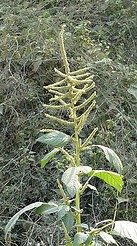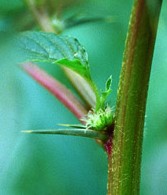 Spiny pigweed is an annual native to tropical America but has spread into the eastern US and California where it inhabits disturbed areas including cultivated fields, roadsides, and lawns. In nitrogen-rich soil the plants may concentrate nitrates in their leaves which can cause health problems if eaten. The stems, leaves, and seeds are edible and considered tasty; various parts of the plant have been used medicinally for the treatment of a variety of ills,and for green and yellow dye.
Spiny pigweed is an annual native to tropical America but has spread into the eastern US and California where it inhabits disturbed areas including cultivated fields, roadsides, and lawns. In nitrogen-rich soil the plants may concentrate nitrates in their leaves which can cause health problems if eaten. The stems, leaves, and seeds are edible and considered tasty; various parts of the plant have been used medicinally for the treatment of a variety of ills,and for green and yellow dye.
Description
 Plants grow about two to five feet tall and are erect and much branched. The reddish stems are smooth and bear egg-shaped to diamond-shaped leaves one to four inches long on petioles as long as the leaves. A pair of sharp rigid spines ½” long occur at each leaf node. The small green male and female flowers are found on different parts of the same plant; male flowers are carried in long terminal spikes while the female flowers are in roundish axillary clusters subtended by the spines. Seeds are very small but abundant; a single plant can produce up to 235 thousand in a single season. Plants are anchored by taproots with networks of fibrous feeder roots.
Plants grow about two to five feet tall and are erect and much branched. The reddish stems are smooth and bear egg-shaped to diamond-shaped leaves one to four inches long on petioles as long as the leaves. A pair of sharp rigid spines ½” long occur at each leaf node. The small green male and female flowers are found on different parts of the same plant; male flowers are carried in long terminal spikes while the female flowers are in roundish axillary clusters subtended by the spines. Seeds are very small but abundant; a single plant can produce up to 235 thousand in a single season. Plants are anchored by taproots with networks of fibrous feeder roots.
Control
Since spiny pigweed is an annual removal before seed set and an important part of control. This can be done by hand pulling, tilling, or mowing although several mowings will be necessary. All plants should be bagged and removed from the site because of the prolific seed production. The seed germinate best on the soil surface so mulching or tilling the soil to bury the seeds more than ¼” can significantly reduce germination. For large or severe infestations herbicides containing dicamba are effective. Crossbow is also effective.